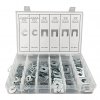Thank you for the answers. The car has heavy steering so probably both camber and castor are wrong. I've been reading the various forum threads on the same topic, and have come to the conclusion that I have two ways to go. It might be a bit of unnecessary work to go via option 1, but if it's a simple and quick job, I'll have time to do it so I can use the car this summer. I assume that option 2 takes considerably more time and therefore should be done this winter.
Option 1. Quick fix to adjust camber to get clearence of the steering arm, in order to fix it properly at a later time according to option 2 below:
1. Ask a workshop to measure the wheel angles to find out the "starting position".
2. Buy an assortment of shims. I have seen a link to Amazon for an assortment of shims. I have also seen another variant that is used e.g. on Triumph. Can both of these work, see pictures?
3. Shim the inner mounts by loosening the top pivot bolts from behind the glove boxes so the mount will pull away from the bulkhead. Add some shims and re-tighten. [Is this really an appropriate way? Can't the threads be damaged by the spring tension?]
Option 2. Doing it properly by replacing bushes as first step, then shims if needed to get the right camber:
1. Remove the fenders for easier access.
2. Follow the pinned thread about removing the spring. I get the feeling from reading the forum threads that it is extra risky to loosen the spring on these cars, compared to other cars with McPherson. Is that right?
3. Change ball bushes and top link bushes (rubber ones, not poly due to squeak).
4. Reassemble, and hope that the wheel angles will be correct, otherwise adjust the camber with shims.
Any comment on this?










